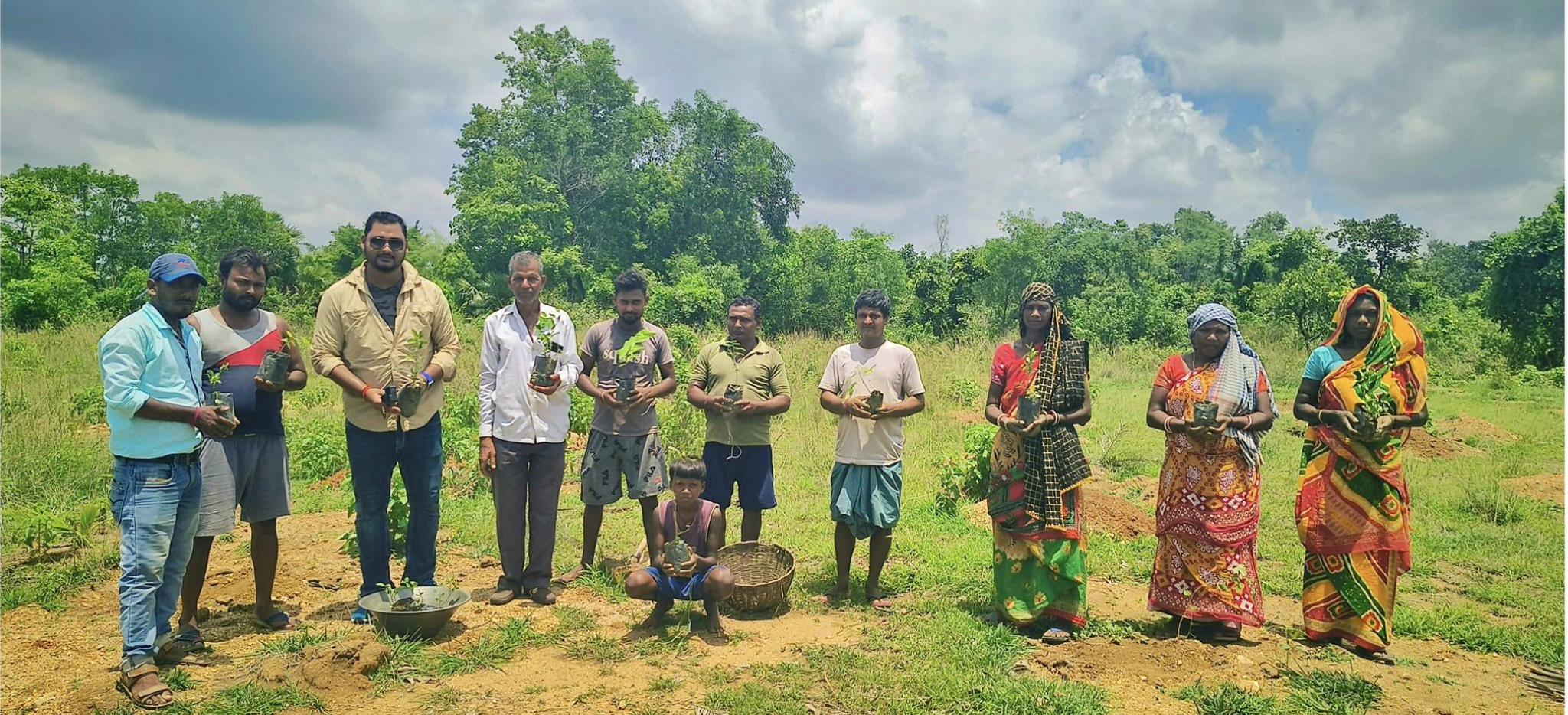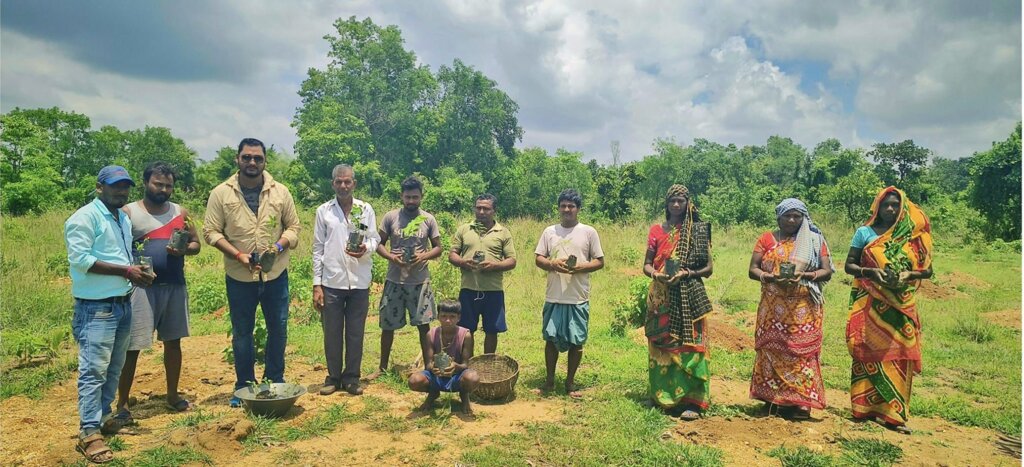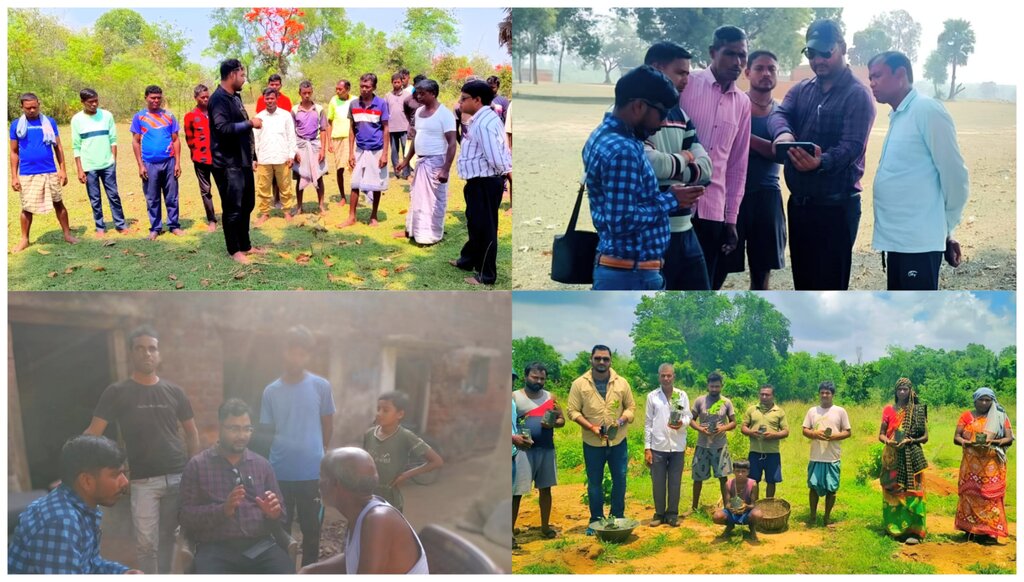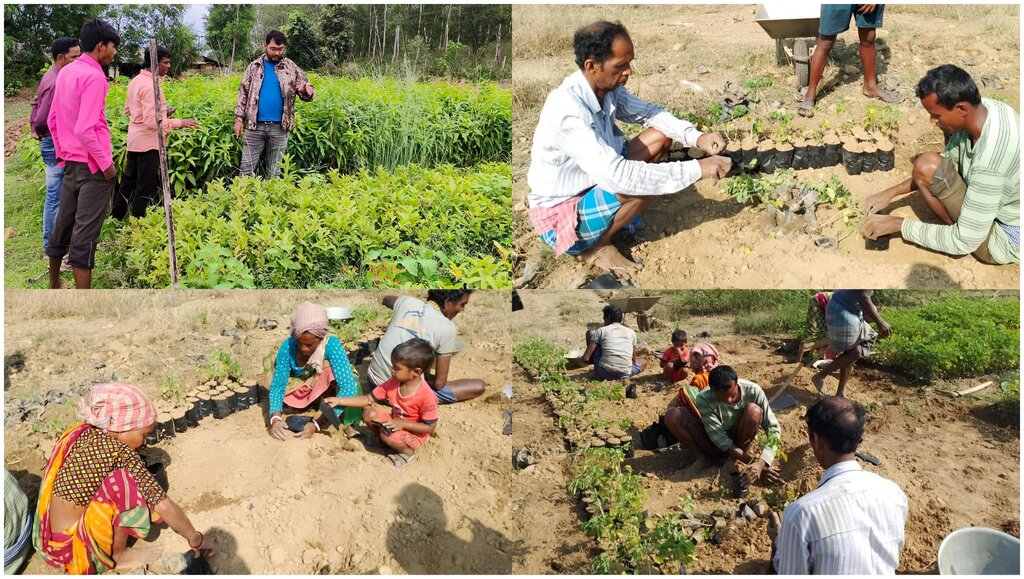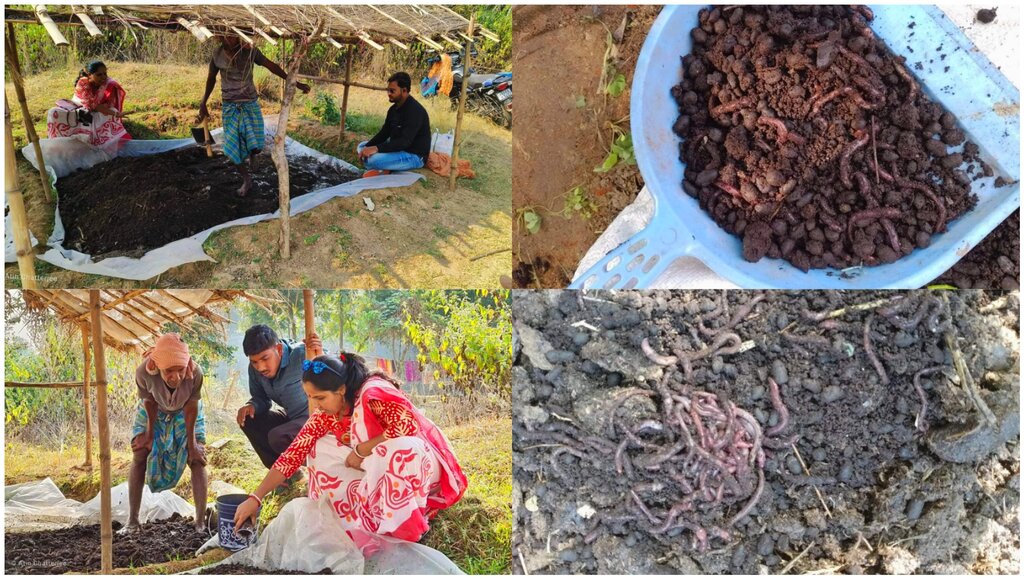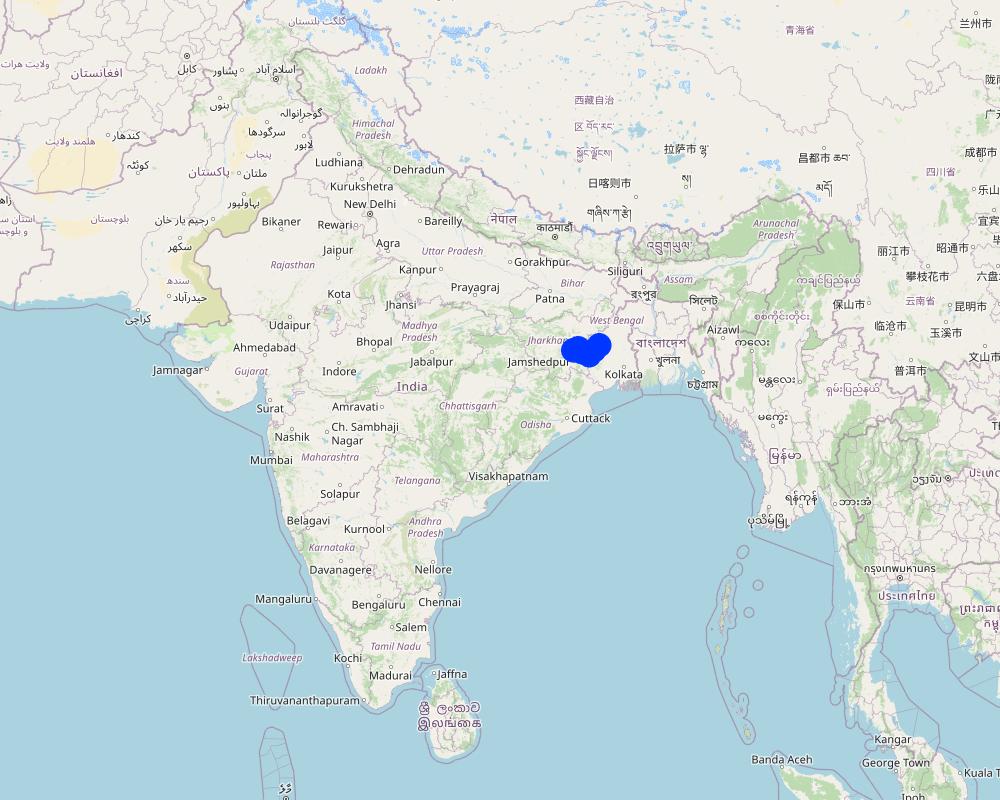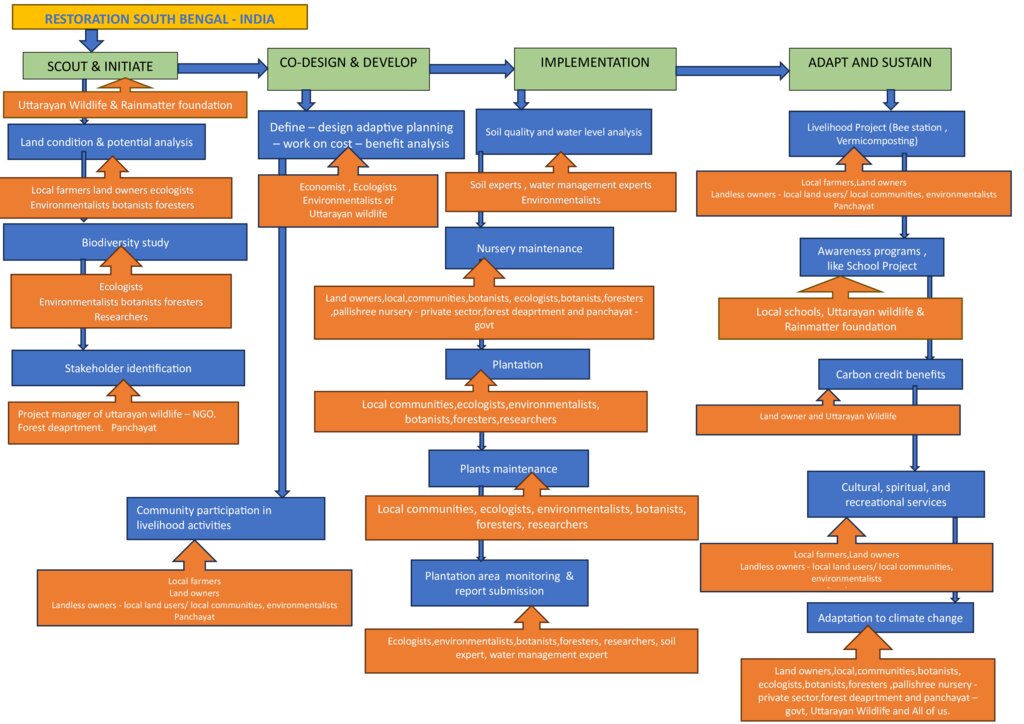Community-led participatory and self sustainable land restoration in India [Inde]
- Création :
- Mise à jour :
- Compilateur : DIYA BANERJEE
- Rédacteur : –
- Examinateurs : Nicole Harari, William Critchley, Rima Mekdaschi Studer
UW - RM Restoration
approaches_7117 - Inde
Voir les sections
Développer tout Réduire tout1. Informations générales
1.2 Coordonnées des personnes-ressources et des institutions impliquées dans l'évaluation et la documentation de l'Approche
Nom du projet qui a facilité la documentation/ l'évaluation de l'Approche (si pertinent)
Community led participatory and self sustaining degraded land restoration in West Bengal (UW - RM)Nom du ou des institutions qui ont facilité la documentation/ l'évaluation de l'Approche (si pertinent)
Uttarayan Wildlife (UW) - Inde1.3 Conditions relatives à l'utilisation par WOCAT des données documentées
Quand les données ont-elles été compilées (sur le terrain)?
16/11/2021
Le compilateur et la(les) personne(s) ressource(s) acceptent les conditions relatives à l'utilisation par WOCAT des données documentées:
Oui
1.4 Références au(x) questionnaire(s) sur les Technologies de GDT
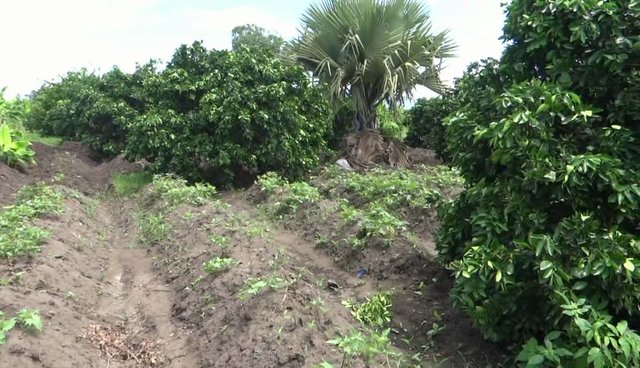
Fruit tree growing for restoration of degraded lands [Ouganda]
Fruit trees of Mangoes (Mangifera indica) and Oranges (Citrus sinensis) are grown on degraded land to improve soil fertility through deep soil nutrient mining and litter of leaves.
- Compilateur : Kamugisha Rick Nelson
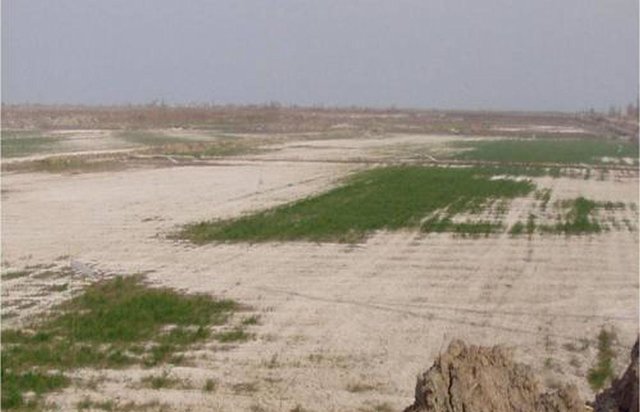
Агролесная мелиорация для реабилитации деградированных орошаемых земель (ИСЦАУЗР) [Ouzbékistan]
На участке пахотной земли, не используемой из-за сильного засоления и заболачивания, создается плантация из солеустойчивых древесных пород, преимущественно с азотофиксирующей и высокой биодренажной способностью
- Compilateur : Rustam Ibragimov
2. Description de l'Approche de GDT
2.1 Courte description de l'Approche
A community-led participatory approach is being implemented in West Bengal to revive and regenerate a broken and degraded landscape through sustainable land management. Local people take the lead in both action and the development of a long-term management plan.
2.2 Description détaillée de l'Approche
Description détaillée de l'Approche:
Much too long and not written as text. I have summarised and edited the language. One omission was any mention of who “we” are. I have said Uttarayan Wildlife. Is this correct? Please check that and my other edits in the following which I have entered online.
A community-led participatory approach is being implemented in West Bengal to revive and regenerate a broken and degraded landscape through sustainable land management. The approach is facilitated by Uttarayan Wildlife, an NGO. Local people take the lead in both action and the development of a long-term management plan. The identified potential/objective is sustainable and integrated business-driven landscape restoration through community participation. It is hoped to enable local communities to become part of a new generation of business professionals that will take part in integrated landscape management and business-driven landscape restoration.
The direct and indirect stakeholders involved are:
1. Local farmers, and local communities;
2. Local schools and colleges; and
3. Local government authorities
A group of facilitators guide communities in the process of recovery of damaged ecosystems. We try to guide the improvement of land towards its full potential which in our case is a traditional natural forest called Sutan – Bankura – South Bengal. It’s an approach to address a systematic crisis.
The overall goal is to achieve land degradation neutrality (LDN). With landscape restoration, that's more than just the recovery of land because a landscape is also a community. People can revitalize an area, and an economy that restores and uses the landscape with sustainable business.
We work in natural and combined zones in a mosaic restoration pattern and follow basic steps through multi-stakeholder partnerships. The sequence is as follows:
Scout and Initiate:
1. Land condition and potential – analysis and recommendations
2. Biodiversity and native forest reference studies
3. Stakeholder identification and dialogue
Co-design and co-develop:
4. Define and design adaptive planning, work on cost–benefit analyses for transformative change with TEK AND LEK and scientific study strategies/drivers for integrated landscape restoration
5.Develop an ecosystem with all possible community participation in livelihood activities
Implementation:
6. Work on:
a. Soil and water depletion
b. Seeding and plantation through nature-based solutions
c. Unsustainable grazing practices
d. Maintenance
e. Monitoring and evaluation for early learning and to adapt a theory of change
Adapt and Sustain:
7. Link livelihood activities with ecological benefits so that the community starts keeping financial capital/business in mind – and create a business case
8. A period of 20 years is minimum to see all the ‘returns’ which can be added with carbon credit benefits to make it permanent.
9. Cultural, spiritual, and recreational services
10. Adaptation to climate change
Scaling up and replication is the ultimate objective – and we will hand-over to the local community using “exit policies”, allowing entrepreneurs/farmers to develop the right skills and knowledge to independently run successful restoration businesses. We hope to scale this model beyond state boundaries with similar issues and potentials. Throughout, we will practice a public – private - partnership (PPP) to strike the right collaborations and partnerships for an efficient Business Model Canvas in order to achieve successful sustainable ecosystem restoration with the community.
In the initial stage local stakeholders were very wary in terms of trust and faith since they were voluntarily pledging their land, time and resources. With time as the model was tested successfully there has been participation from all quarters.
2.3 Photos de l'approche
Remarques générales concernant les photos:
Since most efforts are community participatory-led, this gives the local sense of ownership and sustenance making it long term sustainable.
2.4 Vidéos de l'Approche
Commentaire, brève description:
https://www.youtube.com/watch?v=MASkUcKPcUU&t=89s&ab_channel=UttarayanWildlife
Our last two years of activities in a snapshot!
Date:
01/11/2023
Lieu:
Ranibund , Gorshika, Jhilimili, Dhatala, Kechonda, Ayodhya. Bankura and Purulia
Nom du vidéaste:
Atin Chatterjee
Commentaire, brève description:
https://www.youtube.com/watch?v=hZri4LpAYOQ&ab_channel=UttarayanWildlife
This is a Before and After Plantation feedback from the local farmers!
Date:
13/12/2023
Lieu:
Gorshika - Purulia
Nom du vidéaste:
Atin Chatterjee
2.5 Pays/ région/ lieux où l'Approche a été appliquée
Pays:
Inde
Région/ Etat/ Province:
West Bengal
Autres spécifications du lieu :
Bankura, Purulia
Map
×2.6 Dates de début et de fin de l'Approche
Indiquez l'année de démarrage:
2021
Date (année) de fin de l'Approche (si l'Approche n'est plus appliquée):
2027
Commentaires:
Its a 5 year long approach to empower the locals to continue for the next 10-20 years.
2.7 Type d'Approche
- fondé sur un projet/ programme
2.8 Principaux objectifs de l'Approche
Sustainable and Integrated landscape management and business-driven landscape restoration of degraded ecosystems and landscapes with community participation - enable local communities to become part of a new generation of business professionals that will take part in integrated landscape management and business-driven landscape restoration in a long term sustainable way.
2.9 Conditions favorisant ou entravant la mise en œuvre de la(des) Technologie(s) appliquée(s) sous l'Approche
normes et valeurs sociales/ culturelles/ religieuses
- favorise
The in-built social and religious belief of nature being good enables the project to penetrate easily among locals.
- entrave
The traditional practice of paddy cultivation which presently is of very low yield and loss making but the older generation would not like to try the new agroforestry method or multi cropping system which will regenerate the soil increasing cultivation.
disponibilité/ accès aux ressources et services financiers
- favorise
Since its in a start-up mode with investment from Corporate Social Responsibility funds(this is a mandate from India government to all companies running business in India), it enables the project to penetrate smoothly.
cadre institutionnel
- favorise
The ground level institutional setting in villages have helped us to communicate, facilitate and implement since locals understand the long term benefit.
collaboration/ coordination des acteurs
- favorise
The local farmers, landless labours, schools and colleges, local panchayats coordinate to procure degraded land, participate together to form committees and do long term maintenance of their planted lands.
cadre juridique (régime foncier, droits d'utilisation des terres et de l'eau)
- favorise
We dont have any formal legal tenure since its a voluntary and participatory mode to procure land from land owners. This enables us to build trust with the locals.
cadre politique
- favorise
We together with locals adhere to basic country level and land level policies.
gouvernance foncière (prise de décisions, mise en œuvre et application des décisions)
- favorise
Land governance is wholly in the hands of the land owners including all aspects of decision-making, implementation and enforcement. We just enable and empower.
connaissances sur la GDT, accès aux supports techniques
- favorise
Most of the ecology knowledge is derived from our local farmers and their deep understanding of land, soil, water and plants. We also have a team of botanists and ecologists who have done extensive biodiversity study for reference. We have consultant scientists on soil, plants, water levels.
marchés (pour acheter les intrants, vendre les produits) et prix
- favorise
Target markets are the locals or district level or the nearest big town. Most of our livelihood empowerment would be locally used and sold locally too.
- entrave
Transport cost would be the only hindrance with respect to sending local produce in far away markets.
charge de travail, disponibilité de la main-d'œuvre
- favorise
Availability of man power is onus of the local committee which mostly makes the process smoother.
- entrave
There are cultivation seasons, festivals which hinder the process now and then but its not a show stopper.
3. Participation et rôles des parties prenantes impliquées dans l'Approche
3.1 Parties prenantes impliquées dans l'Approche et rôles
- exploitants locaux des terres / communautés locales
Local farmers
Land owners
Landless owners
Equal participation
- Spécialistes de la GDT/ conseillers agricoles
Soil experts
Water management experts
Botanists
Ecologists
Planning
Expert mitigation advise
- chercheurs
Environmentalists
Botanists
Foresters
Biodiversity study
Plant health study
New approach
- enseignants/ élèves/ étudiants
Teachers
School management
Students
Participate in nature awareness, walks, knowing biodiversity
Plantation drives
- ONG
Uttarayan Wildlife
Main implementation
- secteur privé
Rainmatter Foundation
Pallishree Nursery
Funding
Expert consultation
- gouvernement local
Forest Department
Panchayat
Data support
Community Support
Si plusieurs parties prenantes sont impliquées, indiquez l'organisme chef de file ou l'institution responsable:
NGO - Uttarayan Wildlife
3.2 Participation des exploitants locaux des terres/ communautés locales aux différentes phases de l'Approche
| Participation des exploitants locaux des terres/ communautés locales | Spécifiez qui était impliqué et décrivez les activités | |
|---|---|---|
| initiation/ motivation | auto-mobilisation | Local farmers and committees: Voluntary participation in pledging their degraded lands for the program to revive and restore. UW approached with the plan. Participate in initiating the program and motivating other farmers to join. |
| planification | interactive | Together with our SLM expert team, the locals interact and plan areas of plantation, use and share their traditional knowledge to mark areas of water, soil quality, cattle grazing and accordingly the plantation map is planned. |
| mise en œuvre | interactive | To implement the plan the locals/stakeholders involved create local committees to organise labourers, local resources for a smooth implementation. |
| suivi/ évaluation | auto-mobilisation | The local committees are responsible for taking care of plants - watering, checking on health and reporting, creating barriers against cattle grazings, fire etc. They implement their own mulching techniques and use organic fertiliser to safe guard plants. Due to local participation the mortality rate of plants have been less than 20% which is global standard. |
| soutien extérieur | We harness expertise of biologists, botanists to document the process and inspect time to time. |
3.3 Diagramme/ organigramme (si disponible)
Description:
The above flow chart shows the approach/methodology and the various stakeholders involved at each stage
Auteur:
Diya Sur
3.4 Prises de décision pour la sélection de la Technologie/ des Technologies
Indiquez qui a décidé de la sélection de la Technologie/ des Technologies à mettre en œuvre:
- principalement les exploitants des terres soutenus par des spécialistes de la GDT
Expliquez:
Its a joint partnership in deciding and planning the use of technology/methodlogy as per the condition of the land and weather.
Spécifiez sur quelle base ont été prises les décisions:
- l'évaluation de connaissances bien documentées en matière de GDT (prises de décision fondées sur des preuves tangibles)?
- les résultats de recherches?
- expériences et opinions personnelles (non documentées)
4. Soutien technique, renforcement des capacités et gestion des connaissances
4.1 Renforcement des capacités/ formation
Une formation a-t-elle été dispensée aux exploitants des terres/ autres parties prenantes?
Oui
Spécifiez qui a été formé:
- exploitants des terres
- personnels/ conseillers de terrain
Si pertinent, spécifiez le genre, l'âge, le statut, l'ethnie, etc.
Local farmers of different age, social status are trained including women. Gender split is 40:60(women and men consecutively)
Formats de la formation:
- sur le tas
- entre agriculteurs (d'exploitants à exploitants)
- zones de démonstration
- réunions publiques
Thèmes abordés:
1. Program planning and use of technology/methodology
2. Soil testing
3. Biodiversity checking
4. Vermicompost creation
5. Standard operating procedure for plantation maintenance
6. Bee station maintenance
Commentaires:
Locals absorb very well and show enthusiasm and share their traditional experiences.
4.2 Service de conseils
Les exploitants des terres ont-ils accès à un service de conseils?
Oui
Spécifiez si le service de conseils est fourni:
- dans les champs des exploitants?
Décrivez/ commentez:
Develop SOP as taught by ecology experts for plantation and maintenance of plantation areas and nursery.
Testing soil conditions by soil experts
Biodiversity surveys to check on environmental health of the surroundings with botanists and biologists
Expert foresters help in planning plantation as per land and water conditions
4.3 Renforcement des institutions (développement organisationnel)
Des institutions ont elles été mises en place ou renforcées par le biais de l'Approche?
- oui, modérément
Spécifiez à quel(s) niveau(x), ces institutions ont été renforcées ou mises en place:
- local
Décrivez l'institution, ses rôles et responsabilités, ses membres, etc.
Local farmers have set up voluntary committees to participate and implement and maintain degraded land restoration.
Précisez le type de soutien:
- financier
- renforcement des capacités/ formation
Donnez plus de détails:
Program has financial support from CSR funds - Rainmatter Foundation and local knowledge and expertise support from Pallishree including capacity building. We have external partners for support on biodiversity surveys, bee keeping.
4.4 Suivi et évaluation
Le suivi et l'évaluation font ils partie de l'Approche? :
Oui
Commentaires:
We have SOP created and checklists for monitoring and management level evaluations. We do periodic inspections with our external experts to check on the health of the program.
Si oui, ce document est-il destiné à être utilisé pour le suivi et l'évaluation?
Oui
Commentaires:
The SOP and checklists are used for the monitoring and evaluation.
4.5 Recherche
La recherche a-t-elle fait partie intégrante de l’Approche?
Oui
Spécifiez les thèmes:
- écologie
Donnez plus de détails et indiquez qui a mené ces recherches:
We did an extensive biodiversity and phenology research which was carried out by our partner organisation with their botanists, ecologists and foresters for one year. The research paper is being published in ecology forums and science journals.
5. Financement et soutien matériel externe
5.1 Budget annuel de la composante GDT de l'Approche
Si le budget annuel précis n'est pas connu, indiquez une fourchette:
- 10 000-100 000
Commentez (par ex. principales sources de financement/ principaux bailleurs de fonds):
Rainmatter Foundation - Corporate social Responsibility (its a Government of India social mandate to all profit making companies in India to contribute 2% of their net profit to socially responsible programs run by NGO's.
Rainmatter Foundation is a Zerodha(brokerage firm) outfit of CSR.
5.2 Soutiens financiers/ matériels fournis aux exploitants des terres
Les exploitants des terres ont-ils reçu un soutien financier/ matériel pour la mise en œuvre de la Technologie/ des Technologies?
Oui
Si oui, spécifiez le(s) type(s) de soutien, les conditions et les fournisseurs:
They received plants, land preparation, fertiliser, materials to start their livelihood like vermicompost from the program funding.
5.3 Subventions pour des intrants spécifiques (incluant la main d'œuvre)
- aucun
Si la main d'œuvre fournie par les exploitants des terres était un intrant substantiel, elle était:
- payée en espèces
Commentaires:
Rates were as per Indian labour laws.
5.4 Crédits
Des crédits ont-ils été alloués à travers l'Approche pour les activités de GDT?
Non
5.5 Autres incitations ou instruments
D'autres incitations ou instruments ont-ils été utilisés pour promouvoir la mise en œuvre des Technologies de GDT?
Non
6. Analyses d'impact et conclusions
6.1 Impacts de l'Approche
Est-ce que l'Approche a autonomisé les exploitants locaux des terres, amélioré la participation des parties prenantes?
- Non
- Oui, un peu
- Oui, modérément
- Oui, beaucoup
Since its a community driven participatory program, we engage our land and ecologist experts in a dialogue with the locals to identify specify local problems with land degradation and find the most sustainable solution and long term benefits and with our start-up help locals are empowered to implement the solutions in their land in a sustainable way. Such collaborative engagement leads to improved stakeholder participation.
Est-ce que l'Approche a permis la prise de décisions fondées sur des données probantes?
- Non
- Oui, un peu
- Oui, modérément
- Oui, beaucoup
Local traditional evidence based knowledge pertaining to the specific land coupled with our biodiversity survey of nearby reference native forests by our ecology experts makes it easier to make informed decision of land management based on evidence.
Est-ce que l'Approche a aidé les exploitants des terres à mettre en œuvre et entretenir les Technologies de GDT?
- Non
- Oui, un peu
- Oui, modérément
- Oui, beaucoup
As planned and designed by scientific experts and locals specially on forest land management, agroforestry as an approach for degraded land restoration, it was helpful to implement and maintain the SLM technologies since the approach is jointly agreed upon.
Est-ce que l'Approche a amélioré la coordination et la mise en œuvre de la GDT selon un bon rapport coût-efficacité?
- Non
- Oui, un peu
- Oui, modérément
- Oui, beaucoup
Since its a joint management with locals and program experts, coordination is institutionalized and seemless. Due to close coordination, land procurement happens in bigger portions making it cost effective to implement the SLM technologies and manage in long run.
Est-ce que l'Approche a amélioré les connaissances et les capacités des exploitants des terres pour mettre en œuvre la GDT?
- Non
- Oui, un peu
- Oui, modérément
- Oui, beaucoup
Most of the SLM technologies are indigenous
Est-ce que l'Approche a amélioré les connaissances et les capacités des autres parties prenantes?
- Non
- Oui, un peu
- Oui, modérément
- Oui, beaucoup
The local stakeholders have a fair amount of traditional knowledge of land management, reasons for soil degradation or even climatic changes. Our experts with their scientific knowledge enhanced local knowledge and traditional beliefs with evidence based theories. Our team experts and local stakeholders learn from each other and we have regular learning sessions enhancing the program on field. https://youtu.be/YJxOtm6qh-c?si=IR4M4LzOxINBVO7h
Est-ce que l'Approche a construit/ renforcé les institutions, la collaboration entre parties prenantes?
- Non
- Oui, un peu
- Oui, modérément
- Oui, beaucoup
The community led approach built strong local committees who collaborate to plan, design and implement the program together with industry experts from our program team
Est-ce que l'Approche a atténué les conflits?
- Non
- Oui, un peu
- Oui, modérément
- Oui, beaucoup
In the initial days of the program, we have witnessed many conflicts arising out of jealousy between landowners whose land is being rewilded and landless people resulting in deliberate plant destruction. Later we changed the approach to include landowners and landless people to form committees and help each other to build and implement the approach reducing conflicts. One of our other goal is also to reduce man-elephant conflict by creating natural habitats for elephants to rest and eat fodder rather than raiding crops.
Est-ce que l'Approche a autonomisé les groupes socialement et économiquement défavorisés?
- Non
- Oui, un peu
- Oui, modérément
- Oui, beaucoup
The approach is inclusive and doesnt distinguish with landowners or landless people who are largely socially and economically disadvantaged groups and we try to keep a diverse stakeholder base considering minorities, tribals etc.
Est-ce que l'Approche a amélioré l'égalité entre hommes et femmes et autonomisé les femmes et les filles?
- Non
- Oui, un peu
- Oui, modérément
- Oui, beaucoup
Our nursery is mostly women driven and they get employment. We encourage girls from nearby schools to participate in plantation activities.
Est-ce que l'Approche a encouragé les jeunes/ la prochaine génération d'exploitants des terres à s'engager dans la GDT?
- Non
- Oui, un peu
- Oui, modérément
- Oui, beaucoup
Our special mini program under the main Restoration one is to encourage, empower youth/next generation with climate and nature studies, involve them in restoration work in-field and create micro mini ecosystems in their schools for them to nurture. Our goal is to nurture a generation of nature champions who all will carry this movement forward. https://youtu.be/bX4xK6-fnDs?si=ZkwJdV4LmZgq_MUP
Est-ce que l'Approche a conduit à améliorer la sécurité alimentaire et/ou la nutrition?
- Non
- Oui, un peu
- Oui, modérément
- Oui, beaucoup
We address SDG 1 and 2 by creating fruit forest as a food bank/security during times of severe draught which are common in arid regions.
Est-ce que l'Approche a conduit à l'utilisation/ sources d'énergie plus durables?
- Non
- Oui, un peu
- Oui, modérément
- Oui, beaucoup
We use solar energy for all our energy needs specially in nursery.
Est-ce que l'Approche a amélioré la capacité des exploitants des terres à s'adapter aux changements/ extrêmes climatiques et a atténué les catastrophes liées au climat?
- Non
- Oui, un peu
- Oui, modérément
- Oui, beaucoup
One of the bigger goal of this program is to work closely with climate refugees( the local farmers) who are facing harsh climatic conditions, less cultivation/yield, economic slowdown leading to them turning into migration laborers to mitigate climatic disasters like draught due to land degradation. The program wholly addresses land degradation neutrality to enhance soil quality, water levels, increased chances of cultivation through agro-forestry thus mitigating climate related disasters.
Est-ce que l'Approche a conduit à des emplois, des opportunités de revenus?
- Non
- Oui, un peu
- Oui, modérément
- Oui, beaucoup
The program employs directly and indirectly more than 1200 locals in land preparation, nursery, plantation work boosting local economy.
6.2 Principale motivation des exploitants des terres pour mettre en œuvre la GDT
- augmenter la production
Addressing soil degradation, strategic plantation leads to regeneration of health of land and increased fruit and food production
- augmenter la rentabilité/ bénéfice, rapport coûts-bénéfices
The fruit trees and other economically beneficial trees like bamboo etc increases profitability and cost-benefit ration in the long run
- réduire la dégradation des terres
Soil and water reclamation and plantation reduces land degradation
- réduire les risques de catastrophe
Soil and water reclamation and plantation reduces land degradation and reduced risk of climatic disasters
- conscience environnementale
Locals are environment conscious in their own capacity so empowering them helps to strengthen their belief.
- améliorer les connaissances et compétences en GDT
Together with their traditional knowledge and skills of land management, expert trainings and advise helps to enhance SLM knowledge and skills.
- améliorer l'esthétique
Presently hectares of unused barren land makes the area look bare so the approach will rewild and make the area look greener with revived biodiversity.
- atténuer les conflits
Man-man conflict and man-elephant conflict mitigations are few of the outcomes of the approach.
6.3 Durabilité des activités de l'Approche
Les exploitants des terres peuvent-ils poursuivre ce qui a été mis en œuvre par le biais de l'Approche (sans soutien extérieur)?
- oui
Si oui, décrivez de quelle manière:
With an increased cost-benefit ratio in the long term, creation of food bank and increased cultivation due to land degradation neutrality, the locals would be in a better position to carry forward the approach in a sustainable way without any external support. The approach acts as a start-up kit for a better greener future.
6.4 Points forts/ avantages de l'Approche
| Points forts/ avantages/ possibilités du point de vue de l'exploitant des terres |
|---|
|
https://youtu.be/hZri4LpAYOQ?si=twd2yJoek0U1n1B6 As told by the local stakeholders, in past 3 years of the approach/program, they have clearly witnessed land regeneration. |
| They are satisfied by the equal opportunity to plan and design and use their traditional knowledge and skills, reduced man-man conflicts since they work in committees and learning new approaches. |
| They are very happy about increased potential of cultivation and local income. |
| Points forts/ avantages/ possibilités du point de vue du compilateur ou d'une autre personne ressource clé |
|---|
| The approach being community-led, creates a sense of joint land management reducing internal conflicts and working towards a better future. |
| By achieving land degradation neutrality, regeneration boosts local economy impacting as a watershed, better children's education, more strong local policies towards mitigating climatic extreme conditions. |
| What started as a program has now turned into a local community led movement to uplift land degradation and reduce climate disaster and regenerate biodiversity. |
6.5 Faiblesses/ inconvénients de l'Approche et moyens de les surmonter
| Faiblesses/ inconvénients/ risques du point de vue de l’exploitant des terres | Comment peuvent-ils être surmontés? |
|---|---|
| Natural disasters like widespread fire destroying plantations | Create trenches and fire lines to stop spreading |
| Severe climatic condition like drought which makes it impossible to nurture the plants | Create water trenches and regenerate local water sources |
| Faiblesses/ inconvénients/ risques du point de vue du compilateur ou d'une autre personne ressource clé | Comment peuvent-ils être surmontés? |
|---|---|
| Natural disasters like widespread fire destroying plantations | Create trenches and fire lines to stop spreading |
| Severe climatic condition like drought which makes it impossible to nurture the plants | Create water trenches and regenerate local water sources |
7. Références et liens
7.1 Méthodes/ sources d'information
- visites de terrain, enquêtes sur le terrain
10-12
- interviews/entretiens avec les exploitants des terres
5-6
- interviews/ entretiens avec les spécialistes/ experts de GDT
3-4
- compilation à partir de rapports et d'autres documents existants
2
7.2 Références des publications disponibles
Titre, auteur, année, ISBN:
NA( will be published soon)
7.3 Liens vers les informations pertinentes disponibles en ligne
Titre/ description:
Program/NGO website
URL:
www.uttarayanwildlife.org
Titre/ description:
NGO channel
URL:
https://www.youtube.com/channel/UC7q6Ii0lVAUvfDYlsKDMGuQ
Titre/ description:
News articles
URL:
https://www.thehindu.com/news/national/other-states/elephant-corridors-to-be-restored-in-south-bengal/article38316050.ece
Titre/ description:
News articles
URL:
https://timesofindia.indiatimes.com/city/kolkata/5-year-habitat-restoration-plan-for-south-bengal-jumbo-corridors/articleshow/92447156.cms?utm_source=whatsapp&utm_medium=social&utm_campaign=AmpArticleshowicon&fbclid=IwAR3PFI1eoB9eIPgTxftiO_AV7iBDeO2rc-pf-ByvQGlDMfoFauSSCeiS1FU
Titre/ description:
News articles
URL:
ttps://www.thehindu.com/news/national/other-states/elephant-corridors-to-be-restored-in-south-bengal/article38316050.ece?homepage=true
Liens et modules
Développer tout Réduire toutLiens

Fruit tree growing for restoration of degraded lands [Ouganda]
Fruit trees of Mangoes (Mangifera indica) and Oranges (Citrus sinensis) are grown on degraded land to improve soil fertility through deep soil nutrient mining and litter of leaves.
- Compilateur : Kamugisha Rick Nelson

Агролесная мелиорация для реабилитации деградированных орошаемых земель (ИСЦАУЗР) [Ouzbékistan]
На участке пахотной земли, не используемой из-за сильного засоления и заболачивания, создается плантация из солеустойчивых древесных пород, преимущественно с азотофиксирующей и высокой биодренажной способностью
- Compilateur : Rustam Ibragimov
Modules
Aucun module trouvé


